A Preventable Danger
As a driver, you have been given a huge responsibility. Everyone is counting on you to get the goods to the proper destination quickly and safely. You take safety seriously, but even the most experienced drivers can sometimes get distracted. The number one distraction for drivers today? Our cell phones. Even in hand-free mode, multiple studies have shown that drivers could be missing up to half of the visual stimuli around them.
Here’s a disturbing statistic for you. According to the National Highway Transportation and Safety Administration (NHTSA), taking your eyes off the road for a single text while traveling 55 MPH is equal to driving with your eyes closed for the length of an entire football field. Imagine your family members and loved ones surrounded by people driving with their eyes closed at high speeds, perhaps even in a large commercial vehicle. Talk about a sobering reminder of the importance of staying focused while driving!
The NHTSA reported that 3,142 people were killed in distracted driving accidents in 2019, accounting for 8.7% of all crash fatalities that year. Because of the high risk involved, handheld devices have been banned for drivers of commercial vehicles since 2011.
To put it simply, multitasking, especially while driving, is a myth. The human mind simply cannot devote equal attention to multiple tasks at the same time. Any task that takes your mind off the road should be avoided if possible. Not only is distracted driving a major safety concern, it also carries hefty penalties, which include the following:
· Up to $2,750 in fines per offense for drivers
· Up to $11,000 in fines for employers who allow or require drivers to use handheld devices
· Possible driver disqualification for repeat offenders
· Negative impact on Safety Measurement System (SMS) results
What actions count as using devices illegally?
According to the Federal Motor Carrier Safety Administration (FMCSA), you may be fined for the following actions:
· Using at least one hand to hold a mobile phone to make a call
· Dialing a mobile phone by pressing more than a single button
· Reaching for a mobile phone in a manner that requires a driver to maneuver so that he or she is no longer in a seated driving position, restrained by a seat belt
Staying in touch while avoiding distracted driving
Now you understand why distracted driving is a problem. But how can you stay in touch for important messages or calls while still maintaining a safe focus on the road? Luckily, your mobile phone can actually help with some special setting features.
For Apple Users:
Set up the Driving Focus to silence or limit messages and other notifications. Just go to Settings, then Focus. Tap the + sign in the upper right-hand corner and select “Driving.” You can customize the Driving Focus feature to allow specific contacts or allow emergency notifications. Through Driving Focus, you can also automatically share with others that your notifications are silenced so your contacts know you are waiting to respond until you safely reach your destination, or choose an auto-reply to let contacts know you are unavailable. Driving Focus can be set up to turn on automatically for a “set it and forget it” option that always keeps your driving free of mobile phone distractions.
For Android Users:
For every phone with Android 9 or newer, users can set up Focus Mode. Go to Settings, then Digital Wellbeing. You can also search “Focus Mode” under Settings. From there, you are presented with a list of distracting apps. You can choose which ones to silence in Focus Mode and which ones to leave active. Focus Mode can also be added to the Quick Settings menu to more easily turn it on and off.
With just a few taps, you can do your part to keep the roads a safer place for all drivers. You can also spread the word about the dangers of distracted driving to other drivers, your friends, and family. As awareness increases, it is our hope at Trillium Driver Solutions that safety increases as well.



